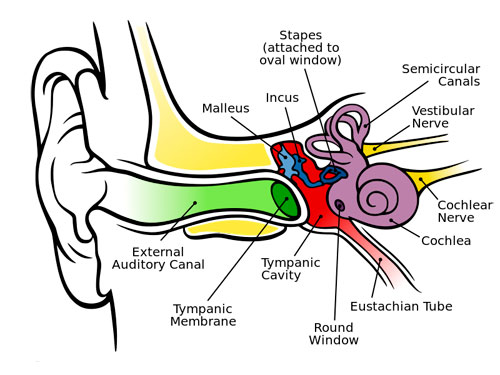The video illustrates how sound travels in the ear. [Video Describing the Process of Hearing and How it Works | MED-EL ]
The ear consists of three parts: the outer ear, middle ear and inner ear.
The outer ear consists of the ear lobe, as well as the external auditory or ear canal that transmits soundwaves to the the ear drum (aka tympanic membrane), which then turns them into vibrations.
The middle ear consists of the auditory ossicles: the malleus, the incus and the stapes. These three tiny bones transmit sound vibrations from the ear drum to the cochlea.
The inner ear contains the cochlea, which is where the actual sensory cells are located. The nerve fibers originating from these cells form the auditory nerve, which transmits the sound stimuli into the brain as electric impulses.

Damage, by illness or otherwise, to the ear, auditory nerve or central nervous system can bring about hearing impairment. With children, the most common causes of hearing loss are related to conductive and inner ear related impariments. A child with a hearing loss of 30 decibels or more in both ears will be offered the use of a hearing aid.
Conductive i.e. middle ear impairment
A child may have a malformed ear canal, limited functionality in the ear drum or auditory ossicles, and as a result, sound is not transmitted to the inner ear. The ear drum and the motion of the auditory ossicles amplify the sound transmitted to the inner ear. If there’s a problem with the middle ear, this amplicfication does not work and speech is heard very softly. A bone anchored hearing aid may help in such cases.
Sensorineural i.e. inner ear impairment
The 25,000 sensory cells and their neural pathways in the cochlea transmit what we hear to our brain. If the sensory cells are not functioning properly, the data transmitted to the brain is incomplete. A child will hear speech, but might be unable to discern all the sounds and words in question, even with the help of a hearing aid. If the amplification provided by a hearing aid is deemed insufficient, a cochlear implant might the appropriate rehabilitative solution.
Unilateral hearing loss
One ear does not hear as well as two. Even at very moderate noisel levels, a child with unilaterla hearing loss will have a harder time hearing speech and has to lip read to understand what is being said, and it makes localizing sound a lot harder, too. Children with unilateral hearing loss are rarely offered hearing aids. Usually problems that arise are addressed by improving the child’s listening environment via seat assignment and other measures.
Sources:
Caring for Children with Special Needs: Hearing impairments. State University of North Carolina
Päivähoidossa on kuulovammainen lapsi – opas päivähoidon henkilöstölle. 2011. Kuuloliitto ry. (in Finnish)
Image of ear: Chittka L, Brockmann A – Perception Space—The Final Frontier, A PLoS Biology Vol. 3, No. 4, e137doi:10.1371/journal.pbio.0030137 (Fig. 1A/Large version), vectorised byInductiveload




